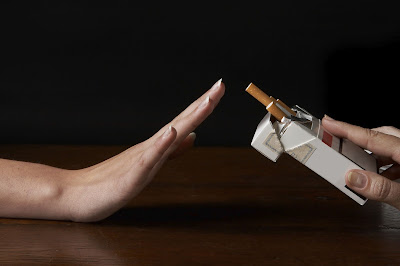When burned, tobacco in cigarettes, cigars, and pipe
mixtures is the source of an array of physiologically active chemicals, many of
which are closely linked to significant changes in normal body structure and
function. At the burning tip of the
cigarette, the 900o C (1,652 F) heat oxidizes tobacco
(as well as paper, wrapper, filter, and additives). With each puff or smoke, the body is exposed
to approximately 4,700 chemical compounds, hundreds of which are known to be
physiologically active toxic, and carcinogenic.
The chemicals have their origin in the tobacco or the over 1,450
additives, including pesticides and other agricultural chemicals. An annual 70,000 puffs taken in by the
one-pack-a-day cigarette smoker results in an environment that makes the most
polluted urban environment seem clean by comparison.
Particulate Phase
Cigarette, cigar and pipe smoke can be described on
the basis of two phases. These phases
include a particulate phase and a gaseous phase. The particulate phase includes nicotine,
water and a variety of powerful chemicals known collectively as tar. Tar includes phenol, cresol, pyrene, DDT, and
a benzene-ring group of compounds that includes benzo [a] pyrene. Most of the carcinogenic compounds are found
within the tar. A person who smokes one
pack of cigarettes per day will collect four ounces of tar in his or her lungs
in a year. Only the gases and the
smallest particles reach the small sacs of the lungs, called the alveoli, where oxygen exchange occurs.
The carcinogen-rich particles from the particulate phase are deposited
somewhere along the air passage leading to the lungs.
Gaseous Phase
The gaseous phase of tobacco smoke, like the
particulate phase, is composed of a variety of physiologically active
compounds, including carbon monoxide, carbon dioxide, ammonia, hydrogen
cyanide, isopyrene, acetaldehyde, and acetone.
At least sixty of these compounds have been determined to be carcinogens
or co-carcinogenic promoters, thus capable of stimulating the development of
cancer. Carbon monoxide is, however, the
most damaging compound found in this component of tobacco smoke.
Carbon Monoxide
Like every inefficient engine, a cigarette, cigar, or
pipe burns (oxidizes) its fuel with less than complete conversion into carbon
dioxide, water, and heat. As a result of
this incomplete oxidation, burning tobacco forms carbon monoxide (CO) gas. Carbon monoxide is one of the most harmful
components of tobacco smoke.
Carbon monoxide is a colorless, odorless, tasteless
gas that possess a very strong physiological attraction for hemoglobin, the
oxygen-carrying pigment on each red blood cell.
When CO is inhaled, it quickly bonds with hemoglobin and forms a new
compound, carboxyhemoglobin. In this
form, hemoglobin is unable to transport oxygen to the tissue and cells where it
is needed.
Although it is true that normal body metabolism
always keeps an irreducible minimum of CO in our blood (0.5% to 1%), the blood
of smokers may have levels of 5% to 10% CO saturation. We are exposed to additional CO from
environmental sources such as automobiles and buses and other combustion of fossils
fuels. By combining a smoker’s CO with
environmental CO, it is little wonder that smokers more easily become out of
breath than nonsmokers. The half-life of
CO combined with hemoglobin is approximately 4 to 6 hours. Most smokers replenish their level of CO
saturation at far shorter intervals than this.
As mentioned,
the presence of excessive levels of carboxyhemoglobin in the blood of smoker
leads to shortness of breath and lowered endurance. Because an adequate oxygen supply to all body
tissues is critical for normal functioning, any oxygen reduction can have a
serious impact on health. Brain function
may be eventually reduced, reactions and judgment are dulled, and of cource,
cardiovascular function is impaired. Fetuses
are especially at risk for this oxygen deprivation (hypoxia) because fetal
development is so critically dependent on a sufficient oxygen supply from the
mother.













No comments:
Post a Comment